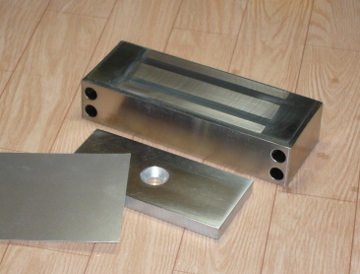| |
|
| |
| Magnetic Traction Locks (maglocks) as constructed
for the electronic security market are usually built from EI transformer
lamination core. The high grade versions use silicon steel laminations,
not stamped sheet metal as is commonly found in Asia. These devices
are fundamentally classical traction electro-magnets. The force between
the stator and the armature (strike plate) varies with Grade according
to the following table. The holding force or Grade for any particular
lock can easily be estimated based solely upon size. All 1200 pound
holding force locks are roughly the same size. |
| |
| Grade 1 |
1500 - 2700 lbs. |
High Security |
| Grade 2 |
1000 - 1400 lbs. |
Medium Security |
| Grade 3 |
500 - 900 lbs. |
Light Security Traffic Control |
|
| |
| The figure below shows a maglock cross-section with
the EI lamination in gray, the coil in orange and a spacer plate
in blue. In normal operation, there is no spacer plate. The strike
plate and the coil lamination (stator) are in direct contact for
maximum force. Insertion of any non-magnetic material will diminish
that force based upon the separation introduced, x. |
| |
|
| |
| The graph below is characteristic of a 1200 pound
holding force magnet and may vary depending upon construction technques.
The curve as shown is not meant to be applicable data, but only an
example. Any lock to be defeated should be tested with an adequate
spacer for optimum performance. It is clear to see that the holding
force diminishes rapidly with very thin non-magnetic material spacers.
It has been observed that a tree leaf blown into the space between
the stator and the armature while the door was closing reduced the
maglock holding force by 50%. |
| |
|
| |
 |
This is a typical vendor's maglock
with a holding force of 1200 pounds. An 0.015 inch aluminum
sheet cut to fit the strike plate and fixed by an adhesive
will go unnoticed and reduce the magnet locks holding force
from 1200 pounds to approximately 300 pounds. Most men can
put that much shoulder into jarring the device open. The door
will appear firmly latched and secure with a holding force
of 300 pounds, but actually will be lightly latched and insecure.
This technique requires very careful inspection with the door
open to spot and will probably go unnoticed by guards casual
inspection. It is nearly impossible to detect by visual inspection
with the door closed. |
|
| |
Any non-magnetic material can be used to defeat
a maglock, such as clear plastic, provided it is easy to over look.
Clearly, red electricians tape might not go unnoticed for very
long. Aluminum tape of the type used for EMI shielding would also
work quite well provided adequate thickness is achieved. Some maglocks
check to see if there is electrical contact between the transformer
laminations of the stator and the metal strike plate. Non-magnetic
metal sheets and metal EMI tape are therefore the preferred methods.
The objective is stealth. How would you know if the maglock below
has been compromised? |
| |
|
| |
| Jackson Research has a proprietary IntelligentMagnetics™ method
of determining if the maglock has been compromised. |
| |
|
|


